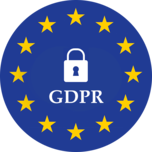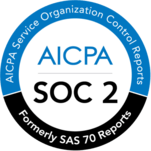What Is Net Promoter Score (NPS)? Your 2022 Guide to the Key Business Metric

Net Promoter Score (NPS) is a metric that customer experience management (CXM) teams need to track.
If you offer experiences that result in an NPS far above your industry average, then you’ll know that:
- You’re on the right track
- Your customers are loyal advocates
But NPS is far more powerful than one simple metric.
Within this exploration of all things Net Promoter Score we will define NPS, explain the nuts and bolts of calculating your NPS score, and break down the components of a Net Promoter Score survey.
Finally, we’ll reveal why your score is just the beginning of your NPS analysis and lay out the most powerful tools that can help you improve your NPS score.
Let’s jump right in – feel free to click around to the section most valuable to you.
- What Is NPS?
- How to Calculate Your Net Promoter Score
- The Importance of Net Promoter Score: NPS Economics
- What Is a Good Net Promoter Score?
- The Net Promoter Score Framework
- How to Create & Send NPS
- How to Analyze NPS with AI & Improve Your Net Promoter Score
- Takeaways
What Is NPS?

Net promoter score, or NPS, is a customer experience management (CXM) metric designed to gauge customer loyalty by asking customers how likely they are to recommend a company on a scale of 0-10.
“On a scale from 0-10, how likely are you to recommend this company to a friend or colleague?”
Your scores, once gathered, are then divided into three groups: Promoters, Passives, and Detractors, according to the following criteria:
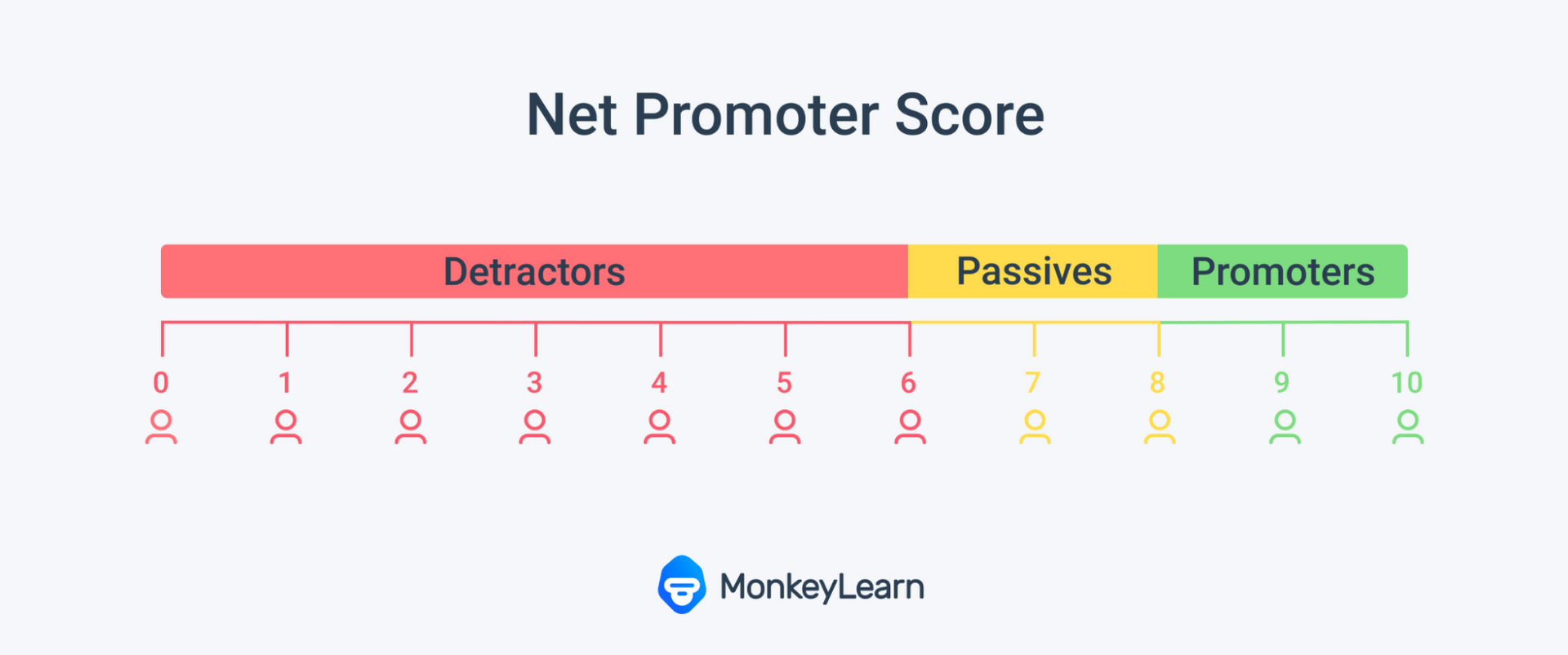
Detractors (scores 0 - 6)
These are unsatisfied customers that could potentially share negative feedback about your business. They’re also more likely to churn.
Passives (scores 7 - 8)
Passives are indifferent about your company. But you’ll need to keep an eye on these customers because they’re at risk of becoming Detractors, which might lead to increased customer churn. On the upside, you might be able to turn them into Promoters.
Promoters (scores 9 - 10)
These are loyal customers that are very likely to promote your company through word of mouth. They’re your company advocates, so you’ll want to keep these loyal customers happy.
Once you’ve grouped your Net Promoter Score respondents, you’re ready to calculate your NPS using its simple formula.
How to Calculate Your Net Promoter Score
Calculating your Net Promoter Score relies on a basic formula. You subtract the percentage of Detractors from the percentage of Promoters.

For instance, if you have 60% Promoters, 20% Passives, and 20% Detractors (60 - 20 = 40), you have an NPS of 40.
It makes sense. If you have more Detractors than Promoters, your Net Promoter Score will be negative; more Promoters than Detractors, your score will be positive.
To make calculating your NPS score even easier, you might want to use this NPS calculator.
Regardless of what your result ends up being, any successful organization will use its Net Promoter Score to arm customer facing teams with actionable, feedback-driven insights.
Your Net Promoter Score is of the greatest value in context, meaning relative to how you could be performing and relative to your respective industry.
Here are some helpful data points to contextualize your NPS calculation:
Per HBR, drawing from 400 companies across 28 industries, the median Net Promoter Score was only 16. That’s a low bar, and underlines the high standard that NPS requires.
Reinforcing this, a 2018 Satmetrix study found NPS averages ranging between -1 (Internet service providers) and 65 (department/specialty stores). That’s a low scatter of scores again underlining the difficulty of attaining a high Net Promoter Score.
While any score above 70 is considered an ‘excellent’ Net Promoter Score, even powerful, global brands consistently fall short – per Verint’s ForeSee Digital Experience index in 2018, Netflix had an NPS of 64, PayPal scored 63, Amazon 54, Google 53, and Apple 49.
Finally, it is worth noting that a perfect Net Promoter Score of 100 has never been achieved by any company that has been surveyed using the metric.
So, that is the lay of the NPS landscape – let’s get into why Net Promoter Score is important.
The Importance of Net Promoter Score: NPS Economics & How It Predicts Business Growth

NPS’s true value lies in the impact of a loyal customer to your bottom line.
CX experts from Bain & Co. developed the Net Promoter Score to be a customer experience metric, and specifically one that measured customer loyalty, due to loyalty’s outsized impact on revenue.
Loyal customers aren’t just important in preventing churn.
Because a high NPS indicates an emotional bond between customer and company, your score can also help you predict growth.
According to Bain & Co, a higher-than-competition Net Promoter Score accounts for 20-60% of a company's organic growth, with industry leaders consistently accruing Net Promoter Scores more than double that of their competitors.
The root cause? According to Fred Reichheld of the Harvard Business Review, when customers form an emotional tie with a company (i.e. become ‘loyal customers’), “[these] promoters essentially become the company’s marketing department”.
The graphic below helps elaborate on the myriad benefits of having a higher percentage of Promoters than Detractors.
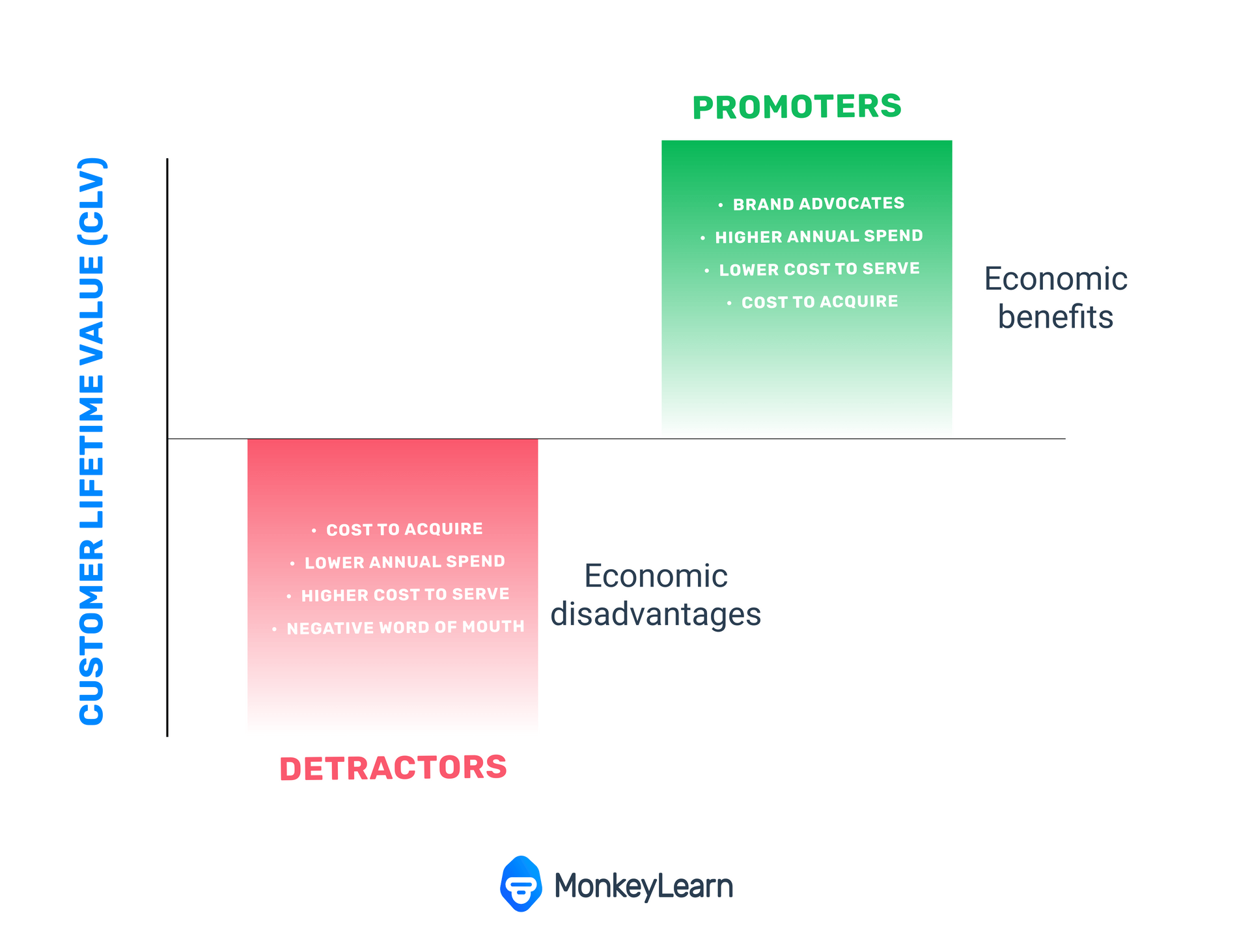
NPS’s massive impact on companies’ ability to remain competitive also stems from game theory: Net Promoter Score is a zero sum game because customers can only occupy one group. Thus, turning a Detractor into a Promoter brings about a double point swing effect per-capita. Situations where this is possible should be given as much attention as possible.
All told, any future-savvy company should move improving Net Promoter Scores to the top of their priority list. Here are some measures you can put into action to drive your Net Promoter Score upwards.
What is a Good Net Promoter Score?
Maintaining a ‘good’ Net Promoter Score in 2022 can be difficult as customer engagement is up 14% compared to last year, and more than 60% of customers have higher expectations when it comes to customer service (Zendesk CX Trends Report 2022.
It’s no surprise then that there is a direct link between customer service and business performance. That means tracking and comparing key performance indicators, like NPS, is more important than ever.
But how do you know what a good NPS score is?
Maintaining a ‘good’ Net Promoter Score in 2022 can be difficult as product availability reaches unprecedented highs due to online marketplaces.
You’ll need to look at your NPS Score both in general and in context relative to industry.
In general, a good Net Promoter Score is any positive score, aka any score above 0:

A positive score means you are on track, i.e. not actively hemorrhaging customers, as you have more promoters than detractors.
NPS benchmarks vary depending on your industry, especially due to a mitigating factor known as customer tolerance level, which we will explain.
In general, according to a 2020 survey by Retently, industry Net Promoter Score benchmarks are as follows:

Identifying NPS benchmarks is a great way to see how well you’re performing compared to your competition, and helps you detect issues that might be stopping you from getting those good scores from your customers.
Industry relative scores or benchmarks are a direct reflection of customer tolerance level.
Customer tolerance level is a metric that reflects how likely customers are to become angry if they feel that their needs aren’t met by a company/service:
- Low-tolerance industries (such as healthcare and airlines) have customers who are very likely to become angry if they are dissatisfied.
- High-tolerance industries (industries operating at lower stakes such as online fashion retailers and other luxury goods) have more tolerant customers who will likely just say ‘meh’ and move on if dissatisfied.
Customer tolerance level is joined by the following factors which also significantly impact Net Promoter Scores:
- Timing – When the survey is delivered can impact results.
- Channel – How you deliver the survey directly relates to response rate.
- Location and Culture – Different cultures have different standards of satisfaction – this is a geographic and cultural subcategory of customer tolerance level.
You can read more in depth explanations of all three of these influencing factors as well as how some companies have subverted expectations in our guide to achieving good Net Promoter Scores in 2022.
Which Net Promoter Score Strategy Should You Use?
Before creating and implementing NPS, you’ll need to know how often you want to send Net Promoter Score surveys.
Do you want to send them quarterly or annually to assess how your customers feel about your overall business from one period to the next.
You’ll be able to use your results to answer questions like, ‘How did customers feel compared to the previous year or quarter?’.
You might also want to send Net Promoter Score surveys after each major customer touchpoint, like after customers make a purchase or get a refund.
This will help you understand how customers feel about specific areas of your business. Questions will need to be worded to reflect your goals. For example, “On a scale from 0-10, how likely are you to recommend this product to a friend or colleague? ”
We recommend using a combination of these two types of NPS surveys, to understand where your business stands on a macro and micro level.
What Can You Measure Using Net Promoter Score?
Remember, you’ll need to know what your goals are before sending out your Net Promoter Score surveys, so that they make sense to you when it comes to analyzing the results. But also so that it makes sense to your respondents – that way they’re more likely to respond.
So ask yourself, ‘what do I want to measure?’.
As we mentioned in the previous section you can measure the overall customer sentiment toward your company or you can home in on one specific area, like customer service, a new product feature, or even a marketing campaign.
The goal is to help you understand which areas of your business need improving. Which customer touchpoint elicits negative scores? In other words, those with more Detractors than Promoters.
eNPS (employee Net Promoter Score)
You can also use NPS surveys to measure employee satisfaction.
This is known as the eNPS (employee Net Promoter Score). The question you’d ask here is “how likely are you to recommend [company name] as a place to work?”.
A recent global study found that nearly 40% of agents feel like they aren’t treated as well as others in the organization.
It’s insights like these that can help you improve your eNPS score.
For example, companies have realized that they need to invest in training programs for agents if they want to deliver customer services that meet customers' expectations.
It’s all about employee happiness, and that’s exactly what eNPS measures.
It’s a metric that’s more important now than ever because unhappy agents feel less empowered to do their jobs well, which ultimately leads to customer dissatisfaction and higher churn rates.
Now that you know what you can measure, let’s break down the components of a Net Promoter Score survey so that you can fine-tune your NPS approach to be the best it can be.
The Net Promoter Score Framework
Usually, a Net Promoter Score survey is made up of two main components. The close-ended question (explained above), that gives you a score between 1 and 10, and an open ended question, meant to contextualize your customers’ scores.
However there are some other questions that Net Promoter Score surveys might contain.
Let’s go through each possible question in the Net Promoter Score framework.
Demographic Questions
It’s very common to fill out your name, age, and gender in surveys, and the same goes for Net Promoter Score. While this data isn’t always necessary, it can be helpful if you want to segment customers during your analysis.
However, try to avoid these types of questions if they are not needed. You want as many of your customers to respond as possible. And overly long surveys might lead to survey fatigue.
The Close-Ended Question
This is the question that leads to the Net Promoter Score, which we explained above. This is the main driver for digging deeper into results and specific areas within your business.
It reveals what is going on in your business.
The Open-Ended Question
Essentially, the close-ended questions give us results and the open-ended question helps explain these results. This is the key driver behind why great NPS is best achieved by a listening-then-adapting approach.
While issues are detected in the close-ended portion of your survey, the open-ended qualitative responses lend in-depth info that can be transformed into valuable nuggets of customer insight.
It reveals the why behind the what.
Make a suggestion
This question or rather, prompt, gives respondents a chance to suggest what you can do to improve their customer experience. It could also serve up some new ideas. Perhaps your competition is doing something differently that you’re not aware of.
How to Create & Send NPS

Helpful survey delivery software can make delivering NPS surveys to your customers simple. Let’s take a look at Hotjar and SurveyMonkey, and how they can streamline and improve your NPS program.
SurveyMonkey
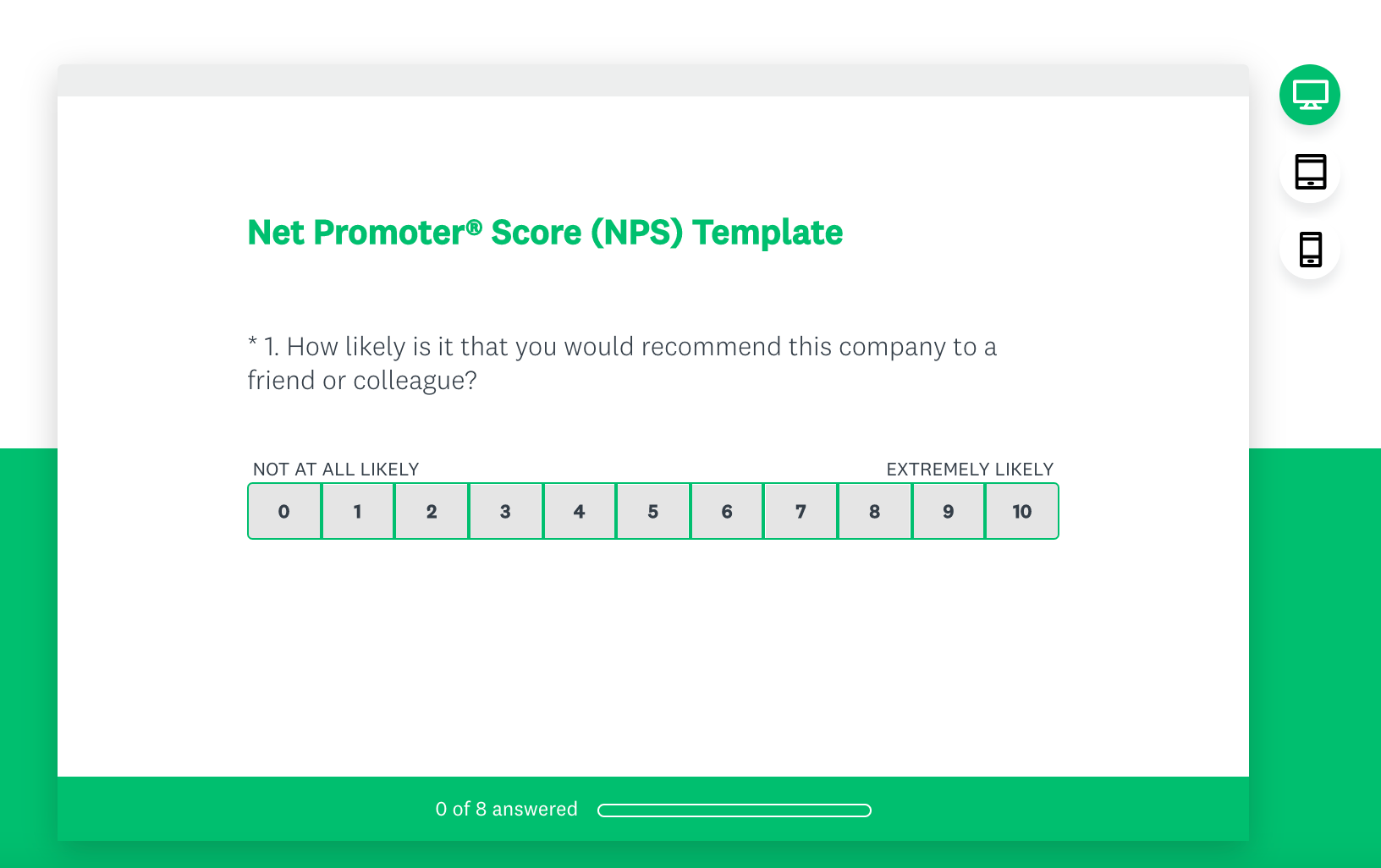
SurveyMonkey is a simple-yet-powerful survey integration platform for businesses who are taking their first steps into customer feedback collection.
The survey creation and delivery tool allows you to create your Net Promoter survey, calculate your score, and see the results all in one place.
SurveyMonkey automatically calculates NPS as your customers respond, and presents the results in a table showing the number (and percentage) of Detractors, Passives, and Promoters.
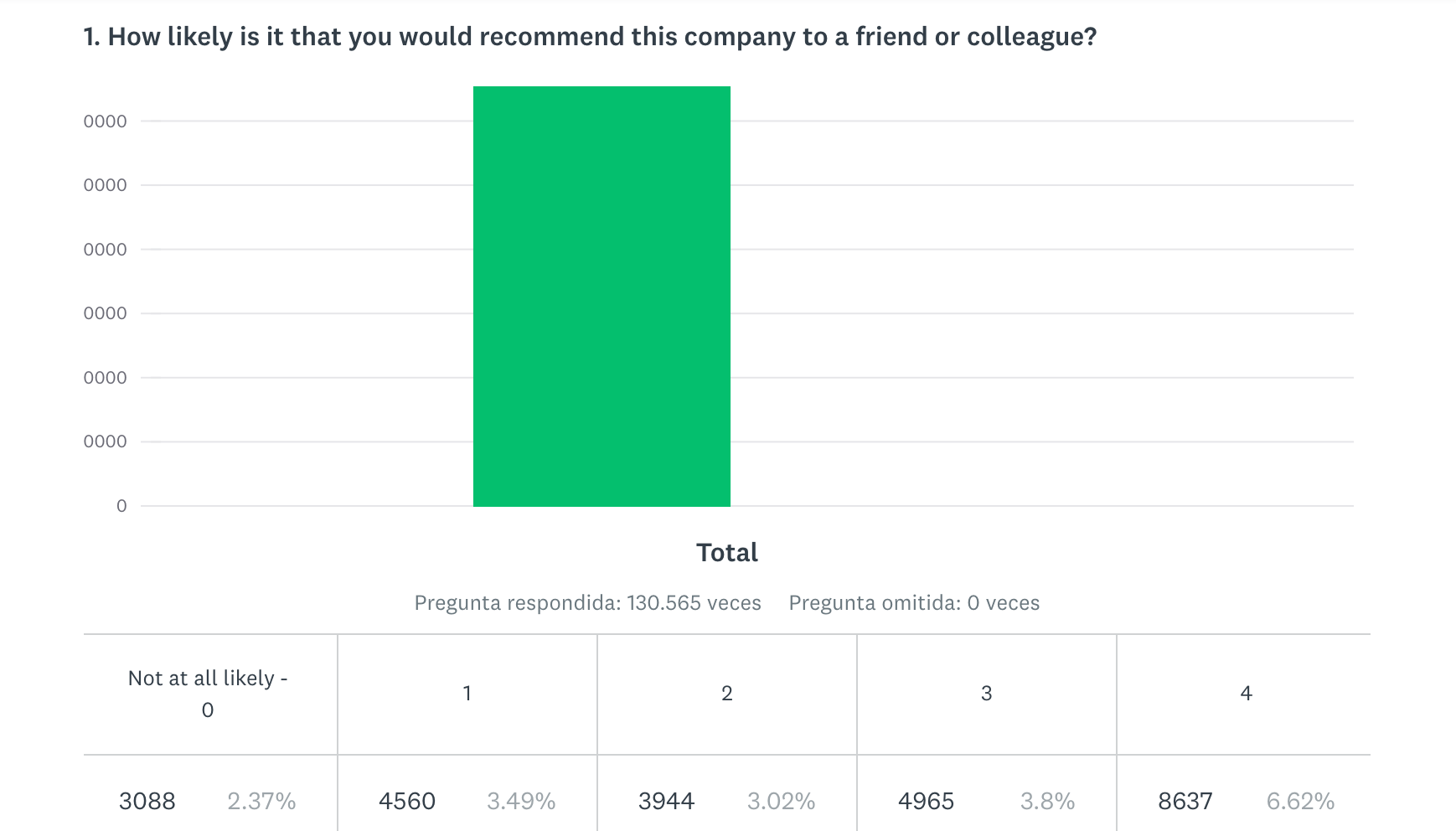
From there, the data it collects can be plugged into more advanced feedback analysis tools, via bespoke APIs, to unlock the open-ended feedback and how it correlates to each NPS group. We’ll dive into how to do this in a bit.
Hotjar
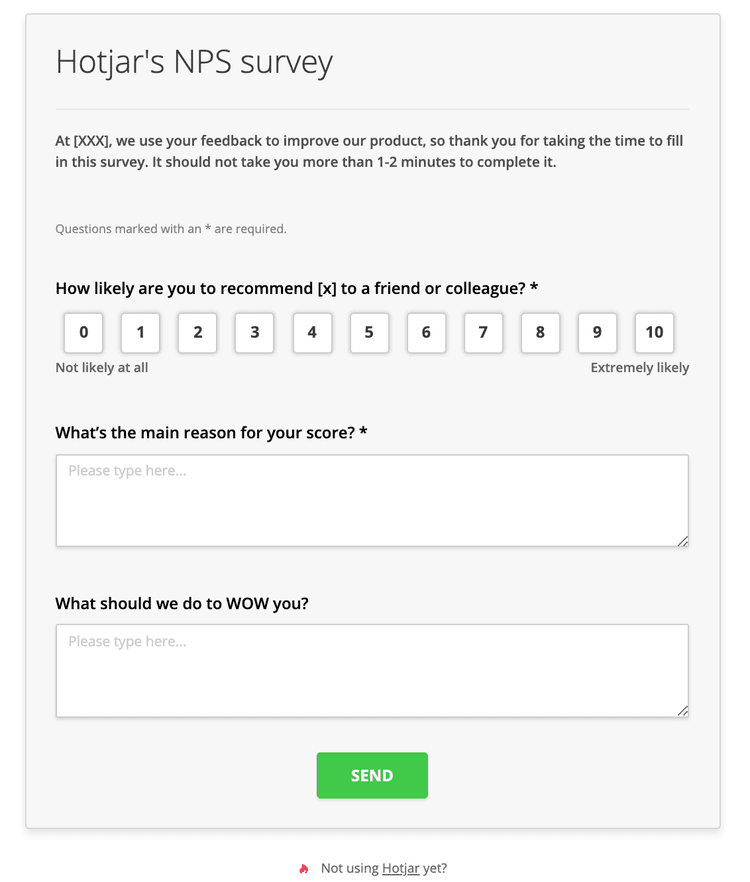
Hotjar uses website heatmaps and behavior analytics tools to help you discover, consolidate, and communicate customer needs.
You can see exactly where customers are getting stuck in a visual and intuitive way and get a complete, nuanced picture of how users are interacting with your site. But that’s not all. Hotjar also allows you to create NPS surveys that show up in your website, or send NPS surveys via email.
- Website NPS Surveys: more immediate, convenient, higher response rates
- Email NPS Surveys: more time to reflect, more effort, more personal
The feedback software then collects the answers, stores the results, and calculates your final NPS score. Again, you can plug your results into more advanced feedback analysis tools that can quantify your open-ended responses and show you the main pain points of each group: Detractors, Passives, and Promoters.
With a focus on delivery and behavior respectively, SurveyMonkey and HotJar give you the power you need to tailor your Net Promoter Score surveys to specific customer groups and see how they respond. With pre-made templates on offer, these services make creating and sending Net Promoter Score surveys easy.
Next, the challenge is analyzing the text data in the open-ended responses (if you’ve included open-ended questions). Tools like HotJar and SurveyMonkey only offer quantitative analysis, so you’ll need to connect AI tools that can interpret and quantify your open-ended feedback.
So, let’s see how that works.
How to Analyze NPS with AI & Improve Your Net Promoter Score

The single best technique to improving your NPS score is listening more effectively to your customers.
This means moving away from the numeric, close-ended half of your Net Promoter Score survey and examining your open-ended, written responses.
It’s in this additional comments box that your customers will explain the ‘why’ behind their rating. Accurately turning open-ended text feedback into quantified, actionable insights is the key to effective listening and improving your Net Promoter Score.
However, going through large amounts of raw text by hand is both time-consuming and prone to error.
Luckily there is a solution - text analysis, powered by machine learning, has transformed feedback analysis by allowing teams to scan and mine large amounts of raw text responses, and transform them into results your customer experience teams can act upon.
Tools like MonkeyLearn Templates make analysis of your open-ended NPS responses really simple, so let’s see how it works.
Analyze NPS Comments with MonkeyLearn Templates
When it comes to NPS survey analysis, MonkeyLearn boasts the power and versatility to outdo all competitors – MonkeyLearn’s AI was specifically built for text analysis and is both powerful enough to handle any response archive and customizable enough to cater to any CX team’s wildest ponderings.
With MonkeyLearn Templates you can analyze and visualize your NPS data – all in one place. Create your Net Promoter Score analysis Workflow by following the steps below:
1. Choose the NPS template to create your workflow:

2. Upload your data:

If you don't have a CSV file:
- You can use our sample dataset.
- Or, download your own survey responses from the survey tool you use with this documentation.
3. Match your data to the right fields in each column:

Fields you'll need to match:
- created_at: Date that the response was sent.
- text: Text of the response.
- score: NPS score given by the customer.
4. Name your workflow:

5. Wait for MonkeyLearn to process your data:

6. Explore your dashboard!

Your dashboard is ready.
Now you can see all your NPS results, both qualitative and quantitative, in one place.
Filter by NPS score and topic to discover the most common themes among each NPS category (Detractor, Passive, Promoter). Then filter by negative sentiment to discover each group’s pains.
Finally, you can also filter by keyword to hone in on exactly what customers are saying – giving you very specific insights that can lead to accurate business decisions.
Once you’ve analyzed your results, it’s crucial you share with other teams, so they can filter by topics that are relevant to them. That way they can also make decisions based on customer feedback.
With a simple share function in the top right-hand corner of the NPS analysis dashboard, MonkeyLearn makes team collaboration really simple.
Takeaways
No matter what way you shake it, Net Promoter Score is a valuable differentiator for businesses.
The higher your NPS score, the better your performance will be.
Implementing an NPS program along with the right tools, will help future-forward customer experience departments get the leg-up on competition for years to come – a key advantage in the rapidly transforming digital market.
It’s never too early to start making brand loyalty a priority.
To jumpstart your Net Promoter Score improvement journey explore MonkeyLearn’s suite of feedback analysis tools, or sign up for a demo to see how you can analyze your NPS results.

